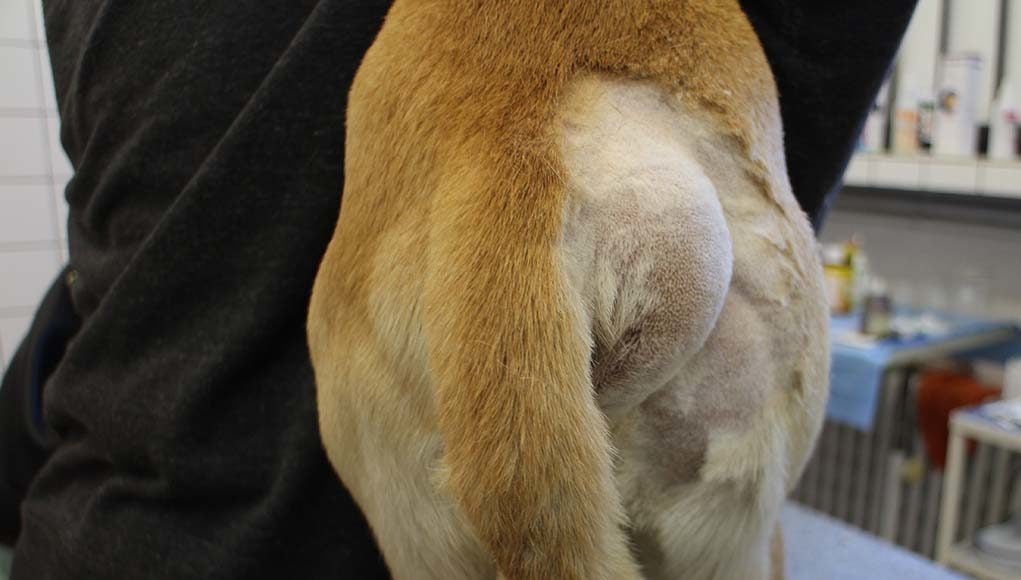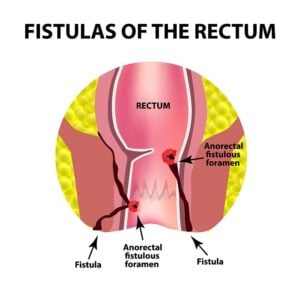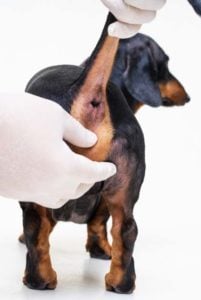Table of Contents
- What are Dog Anal Glands?
- 5 Signs of Dog Anal Glands Problems
- Causes of Dog Anal Gland Issues
- How to Diagnose Dog Anal Glands Problems
- How to Prevent Anal Gland Problems?
- Natural Dog Anal Gland Treatments
- Veterinary Treatments for Dog Anal Glands
- Answers to Common Questions about Dog Anal Gland Problems
- Dog Anal Gland Problems: Before You Go…
While dog anal gland problems are usually not life-threatening, they are relatively common, except for anal gland cancer. Sadly, when untreated, they can affect your dog's quality of life.
Not to confuse dog hemorrhoids, tumors, fissures, or rectal prolapse, dog anal gland issues occur specifically due to blockage of the ducts around the anus.
These ducts remove the excretions of anal glands via openings on either side of the anus.
Is this a serious condition for your dogs?
Well, dog anal gland problems are fairly common.
…appearing in about 2 – 12% of cases with dogs. – Sources: (1, 2, 3).
In this article, we will explain everything there is to know about dog anal glands, including:
What They Are and Their Purpose
Signs of Dog Anal Gland Problems
Treatment at Home and With a Vet
What are Dog Anal Glands?
Anal glands, or anal sacs, are found on both sides of a dog's anus, underneath his tail.
They're small sacs filled with glandular cells that produce a potent yellow fluid consisting of both oils and sweat (9, 10), which can be:
- Watery
- Creamy
- Thick or pasty
- May or may not contain solid materials in it
This fluid then flows through 2 small tubes in a dog's body that opens on either side of the anus.
Generally, they're divided into 2 condition categories:
This pair of small glands is filled with oily fluid with a similar smell to the odor a skunk releases.
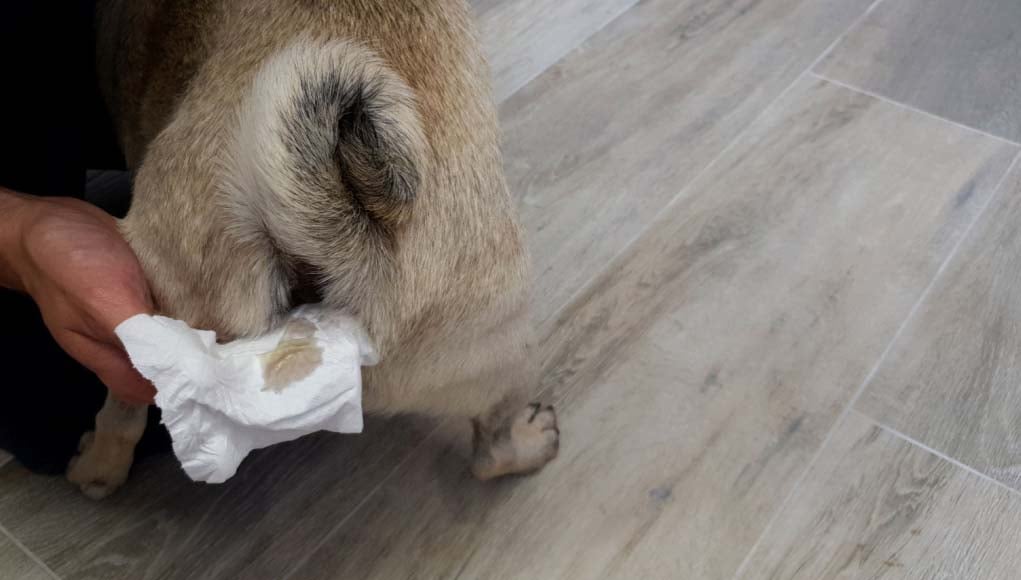
Why Do Dogs Have Anal Glands?
The exact purpose of the dog anal gland remains a matter of debate among experts, but scientists have hypothesized that it could be for one of the reasons below:
1. Marking Territory
The strong, rancid smell that is attributed to anal sac secretions could, in theory, be used as a way for dogs to mark their territory.
Seen on both male and female canines, this could be a way to ward off unwanted visitors by saying, “Hey, I live here.”
2. Health Check
The scent of the secretion does vary depending on the health of the canine in question. Dogs may use it to communicate health or sickness to other dogs.
Also, the scent from one dog's anal glands can reveal to other dogs some information about the animal, such as his gender and approximate age.
3. Lubricant
A dog's anal gland releases oily gunk directly on either side of the anus opening, leading some scientists to believe that this could be a natural lubricant to ease the passing of harder feces.
4. Evolution in Anatomy
Potentially the least useful idea as to why dog anal glands exist is the historical thought.
Dogs may have these glands simply as a leftover from their ancestor's anatomy when it may have been necessary to spray these fluids at predators.
Dog Breeds Prone to Anal Gland Problems
Smaller breeds are more likely to suffer from this blockage because their anal sac ducts are smaller and more prone to blockage.
Breeds more susceptible to anal gland problems include:
- Beagle
- Chihuahua
- Lhasa Apsos
- Cocker Spaniel
- Miniature Poodle
Older dogs are also more likely to suffer from this issue.
If your dog has abnormal positioning of his anatomy, he is most likely to develop anal gland issues as well.
5 Signs of Dog Anal Glands Problems
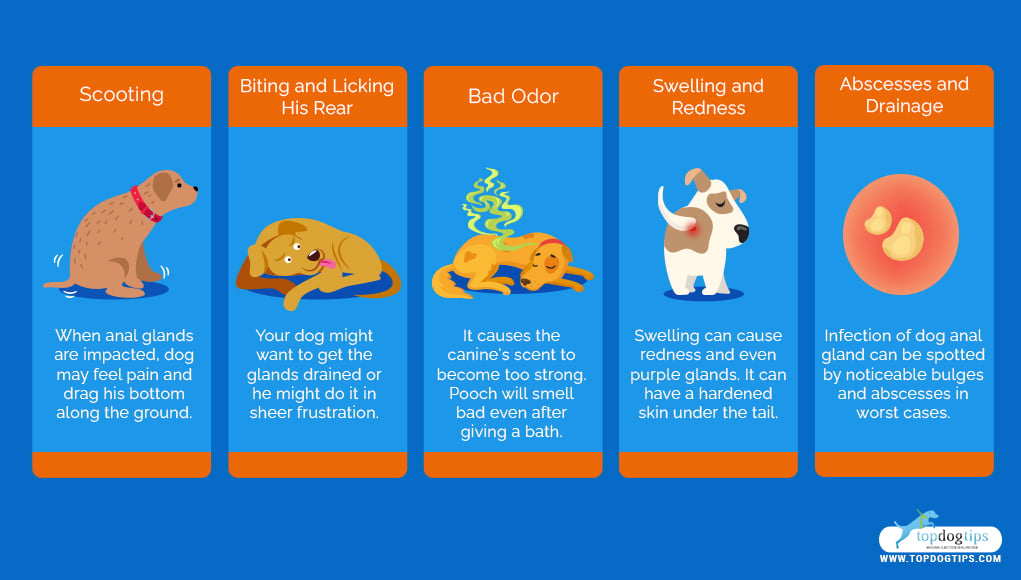
Anal glands usually drain naturally during a dog's bowel movement, but they can sometimes get impacted and clogged up.
This can lead to swelling and infection, or even abscesses. Here are the signs that your dog is having a problem with anal glands:
Scooting
This is usually the first sign.
When a dog's anal glands become impacted, he may feel pain and empty them by dragging his bottom along the ground.
Dog anal glands disease also triggers your pup to scoot due to the following cases:
- Irritation
- Infection
- Blockage
If you notice that your dog is often scooting, it may signal a problem with his anal glands and needs to be looked into.
Biting and Licking His Rear
Another common symptom is biting and licking of the anus.
Your dog might do this to try and get the glands drained, or he might do it in sheer frustration.
He might also lick his paws for the same reason.
Some dogs even chase their tails when they feel uncomfortable or in pain.
Bad Odor
Since dog anal glands are responsible for canines' unique scent, this scent becomes too strong when they get impacted.
If you notice that your pup smells terrible even after you bathe him, then anal glands might be the reason.
Swelling and Redness
Impacted anal sacs can cause the area around the pet's anus to become swollen.
There can also be a change in color in that area since swelling can also cause redness, or in some extreme cases, dog anal glands can even turn purple.
Pets that suffer from chronic inflammation of anal glands can have hardened skin under the tail.
Abscesses and Drainage
If the problem of impacted anal glands is not addressed in the early stages, this can lead to infection.
A dog's anal sac itself can also swell from the pressure and burst. This would result in one of two outcomes:
(a) pus-like liquid will be oozing from the area
(b) either the area surrounding the rectum will appear swollen
Noticeable bulges can spot the dog anal gland infection just under the surface of the animal's anal opening and drainage from the rectum.
In more severe cases, abscesses may appear in the area.
Other Signs
Other potential signs of dog anal gland problems include bleeding in the anal region or straining to defecate.
You may also notice a smelly and greasy discharge, usually brown or tan.
Be on the lookout for indications of an infection.
These can include pus or red spots in the discharge, swelling, and a hole discharging green, yellow, or bloody pus by the anus.
Another sign is bad breath in dogs, but this is not a direct effect of anal gland problems.
Your dog may relieve its discomfort by licking the area. When licking, the dog picks up these rancid secretions in the area, which in turn causes your dog's breath to smell bad.
Causes of Dog Anal Gland Issues
There are many potential causes of dog anal gland issues. Still, the most common one is the inflammation of the anal ducts.
Some of the most common reasons that dog anal glands disease can occur are:
1. Prior Infection
Scar tissue can form if your dog has suffered from a past anal sac infection, which then makes it more likely for impaction and additional infections to occur.
Bacterial, fungal, and parasitic skin infections can also be the cause, as well as hypothyroidism.
2. Past Trauma
Injuries can deform the opening of a dog's anal gland duct and make it difficult for the secretions to escape.
3. Allergies
Ingested or environmental allergens cause inflammation in many different areas of a dog's body and can, in some cases, cause inflammation surrounding the duct opening.
Again, this makes it difficult for anything to get through, and without treatment, this can cause infection.
4. Loose Stools
Diarrhea is another common cause of anal glands because they're more likely to fill when the dog's stools are soft, and there is not enough pressure to empty the glands.
Similarly, constipation can lead to these problems because they lack stools to prevent emptying anal glands.
If your dog suffers from diarrhea, loose stools, or irregular bowel movements, this will place little to no pressure on the colon, which is required to expel the anal glands.
Changes to the consistency of your dog's bowels can also cause issues with the anal glands.
How to Diagnose Dog Anal Glands Problems
Apart from the symptoms of dog anal glands disease, a vet will perform blood work and urinalysis.
Issues with dog anal glands are common, and this is a routine procedure.
And to diagnose problems with dog anal glands, your veterinarian will take a sample of the anal sac contents.
During this procedure, the vet will see if blockages are evident.
Your vet will also examine the concentration of the liquids to see whether they have been there for some time.
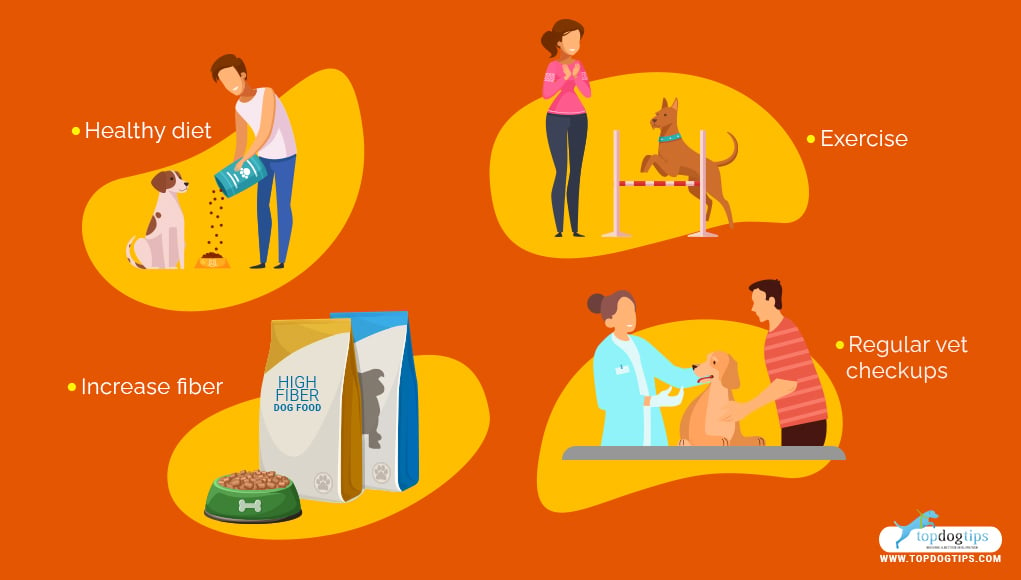
How to Prevent Anal Gland Problems?
Preventing anal gland problems is possible with a proper diet and exercise.
The highest dog anal gland issues risk is present in small, obese animals.
A healthy diet and exercise ensure less risk of digestive problems, especially diarrhea and constipation, thus ensuring the regular emptying of anal sacs.
If your dog suffers from these issues often, try to increase fiber in his diet to make his stools bulkier or switch to high-fiber foods.
Take your pup to regular vet checkups and ensure that your vet checks his perennial area for any signs of anal gland issues.
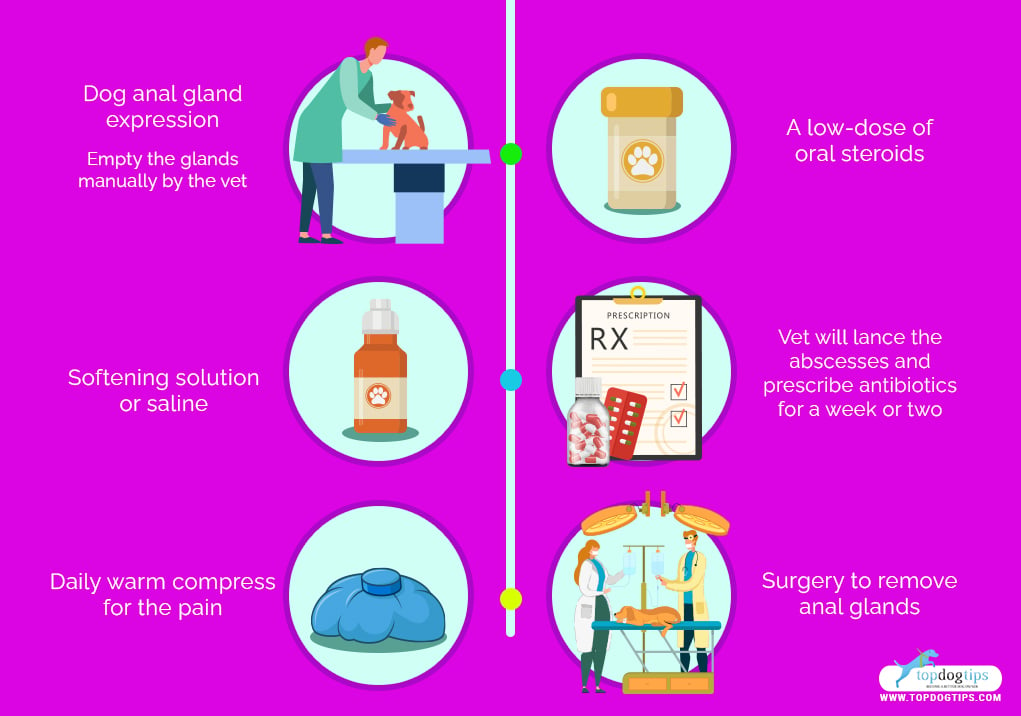
Natural Dog Anal Gland Treatments
Thinking about how to help dogs express glands naturally and without vet intervention?
Well, there are many ways to treat dog swollen anus treatment at home. You may want to check and try these home remedies for impacted anal glands.
Note: When in doubt, it's best to consult with your vet or have him treat your pup instead. We'll discuss the procedures later on.
1. Fiber-rich Dog Food and Fiber Supplements
The best prevention for this condition is feeding a high-quality diet high in fiber and low in fat.
Anal gland secretions can be expelled naturally by regular bowel movements.
But when the fecal matter is too loose, a sufficient amount of fiber in their diet can help (19, 20).
Some dog foods for anal glands are already formulated to contain more fiber.
A few recommended brands you can try include:
- Blue Buffalo Wilderness High Protein Natural Adult Healthy Weight Dry Dog Food and Wet Dog Food
- Instinct Raw Boost Grain-Free Dry Dog Food, Healthy Weight Recipe High Protein Kibble + Freeze-Dried Raw Dog Food
- Hill's Science Diet Dry Dog Food, Adult, Sensitive Stomach & Skin Recipes
Ask your vet about certain foods to help dogs express glands outside of kibble.
Note: Fiber is the best solution to this issue when in its early stages.
However, be wary of drastically increasing your dog’s fiber intake.
Especially if they suffer from pain when going to the bathroom, or worse if there's any bleeding around the anus.
“What do I do then?”
Psyllium is a type of soluble fiber that is of low fermentability.
It has long been used to prevent or treat constipation in dogs, but it can also help treat and prevent anal gland problems.
Use an organic brand like Viva Naturals ($9.42) for your pet. Some other well-rated fiber supplements for anal glands in dogs:
- Glandex Anal Gland Soft Chew Treats with Pumpkin for Dogs
- Diggin' Your Dog Firm Up Pumpkin Super Supplement for Digestive Tract Health for Dogs
- NaturVet – No Scoot for Dogs
2. If Needed, Ensure Weight Loss
Extra weight in dogs will cause their anal glands to be surrounded by more fatty tissue, which means it's harder to empty the dog's anal sacs.
Dogs of a healthy weight are less likely to experience anal gland problems, and even when they do, it's easier to treat them.
Making sure that your pet eats a proportional meal for their breed, age, and height is vital.
This will prevent not only anal sac problems but many other health issues, too.
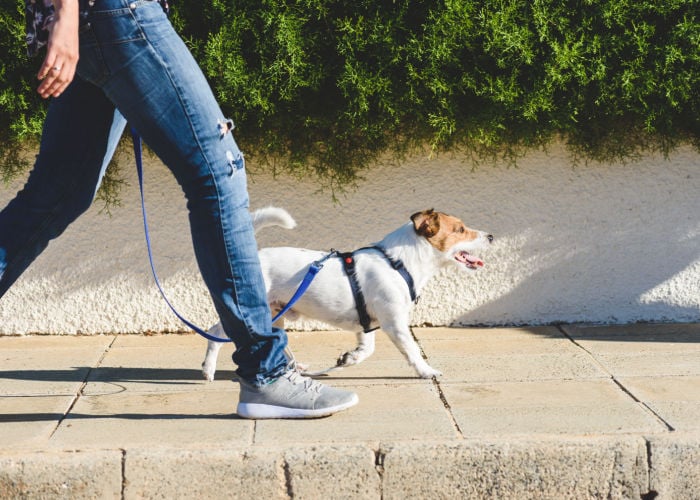
3. Exercise Your Dog More
Getting your dog to move around more through extra playtime, training, vigorous exercise, or longer walks will keep them at a healthier weight.
More exercise will also open up the tubes that connect the dog's anal glands to the outside world.
Vigorous exercises like hiking or long-distance running were shown as an effective way to deal with anal sac problems.
4. Add Omega-3 Fatty Acids (Fish Oil)
Adding fish or vegan omega-3 fatty acid supplements to your dog’s food can help relieve itching and lessen inflammation in the anal sacs.
There are also far more benefits of fish oil for dogs than just fixing your dog's anal glands, many of which may subsequently help treat the condition and prevent further occurrence.
5. Use a Warm Compress
Hold a warm compress against your dog’s anal gland openings.
Either with only water or salted water, it can really help open up the ducts and relieve blockage.
When dealing with this health problem, your pup is likely to have pain in that area.
And a warm compress or heating pack like this one will be very comforting (which you can pair with pet diapers).
6. Check for Allergies
Food allergies are a common reason for inflamed, obstructed anal glands in dogs.
By placing your pooch on an elimination diet and determining the allergen that your dog is reacting to, you can remove this from their diet.
And in turn, remove the risk of future inflammation of the anal sacs.
The best approach is to use novel protein dog foods that contain ingredients that your pet is unlikely to have been exposed to before.
7. Use Stool Softeners
Depending on how bad your dog's anal gland problem is, sometimes it may cause ulceration or abrasions when the sacs are too big.
When this happens, defecating a dog will become very painful.
To reduce the strain and pain, you can use stool softeners for dogs, which are supplements that are either prescribed by your vet or bought over-the-counter, like NaturVet ($11.99) or Pfizer ($12.95).
8. Express Dog Anal Glands Manually
Some dogs have difficulty expressing their anal glands naturally and may require manual assistance to ensure that anal sac impaction or infection will not occur.
Well, this video below will show you how to express dog anal glands at home.
Caution: Do not attempt to do this without your veterinarian's consent and instructions on doing this at home if you're doing it for the first time.
Veterinary Treatments for Dog Anal Glands
1. Experts Expressing the Anal Glands
The immediate treatment for impacted anal glands entails emptying the glands manually by your veterinarian.
This is called dog anal gland expression, done by gently squeezing the liquid from the glands.
Your vet can show you how to express dog anal glands so you can do it yourself at home should they become impacted again.
2. Anti-Inflammatory Drugs
After draining, your vet will likely prescribe anti-inflammatory drugs to relieve the cause of impaction in the first place, as well as fend off any additional swelling caused by expressing the sac.
In recurring or more persistent cases, adding a low dose of oral steroids may speed up recovery and reduce inflammation.
3. Antibiotics
If your dog is suffering from an infection or has a history of them, your vet may administer antibiotics after draining the dog's anal glands to prevent another infection from occurring.
Having said that, overuse of antibiotics can lead to other health issues or resistance.
4. Surgical Removal
In extreme cases of a dog suffering from repeat anal gland infections, removing these is a possibility.
However, there are many risks and complications that can occur during.
After this procedure, therefore, it’s rarely advised except for in cases where the risks are greater to the canine when left untreated.
In severe cases, your vet may suggest surgery if treatment doesn't work or if an anal gland tumor is present.
The vet will perform an anal sacculectomy to remove one or both of your dog's anal glands.
This simple procedure will resolve the problem permanently, but it may lead to fecal incontinence.
Incise an Abscess
If abscesses are present, the vet will probably lance them and prescribe antibiotics for a week or two.
The lancing is performed under anesthesia due to pain when the vet opens and drains the abscesses.
After that, veterinarians will once again prescribe antibiotics, as well as anti-inflammatory drugs.
Answers to Common Questions about Dog Anal Gland Problems
The following should answer the most common questions about dog anal gland problems for those who prefer information in easily digestible chunks.
Anal Gland Expression: How Do You Know If Your Dog Needs It?
Some signs that your dog needs his glands squeezed include licking his bottom, scooting around on the carpet, or leaking either a brownish material or foul smell.
How Do You Treat Anal Gland Problems in Dogs?
Your vet will treat the dog's anal gland problems by draining the fluid from the glands.
In the case of abscesses, they will open and drain them and give your dog anti-inflammatory drugs plus antibiotics.
How to Express a Dog’s Anal Glands
To squeeze or express your dog's anal glands, put on gloves and apply lubricant to your index finger.
Put the index finger in your pup's anus with your thumb on the outside.
Bring these two fingers together, running them along the left side of the anus.
The anal glands should be at around the 4 and 8 o'clock positions.
Use a paper towel and your other hand to collect the fluid.
What Happens When a Dog's Glands Are Full?
If your dog's anal glands are too full, they can cause uncomfortable pressure.
This is when you are likely to notice signs of dog anal gland problems.
Can I Express My Dog's Glands Myself?
Yes, you can express them yourself. You will need gloves, paper towels, and lubricant.
Follow the above instructions for expressing or squeezing the glands.
Will the Anal Gland Issues Occur Again?
Although not always the case, your dog may have recurrent impactions or abscesses on his anal glands.
For example, overweight dogs are more likely to have issues due to their sacs not emptying as they should.
It is also important to note that the issue won't disappear until you eliminate the underlying cause.
Additionally, impaction can lead to scarring and narrowing of the anal ducts. This can increase the likelihood of future issues.
Sometimes, your vet may suggest surgically removing your dog's anal sacs.
Can Dogs Get Hemorrhoids?
For the most part, dogs don't get hemorrhoids. You probably won't live to see it happen to your pet/s
However, this doesn't exclude them from possible injuries in and around the anus.
Dogs can get hemorrhoids very rarely and it is a serious symptom that needs urgent medical attention.
If this is your dog, call your vet immediately.
Dog Anal Gland Problems: Before You Go…
In conclusion, while dog anal gland issues don't threaten your pup's life, they can cause discomfort and pain.
Pay attention to signs like scooting, biting, and licking of the anus and any physical changes in the area around your dog's anal opening.
Feed your dog a healthy diet with enough fiber and exercise regularly to prevent potential anal gland problems.
RELATED READS:
- How to Drain Anal Glands on Dogs
- Anal Gland Cancer in Dogs: Symptoms, Diagnosis & Treatment
- Top 5 Best Digestive Aids for Dogs with GI and Anal Gland Problems in 2023
Disclosure: We may earn affiliate commissions at no cost to you from the links on this page. This did not affect our assessment of products. Read more here and find full disclosure here.


